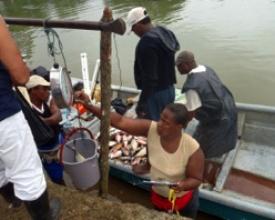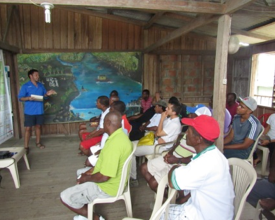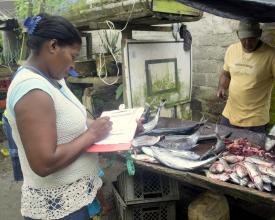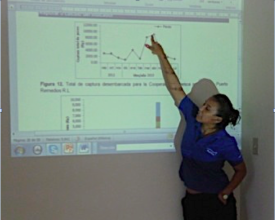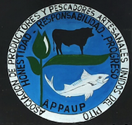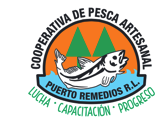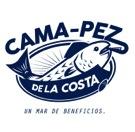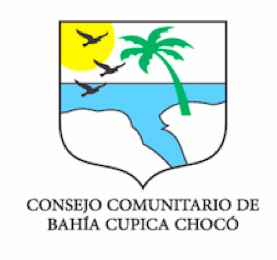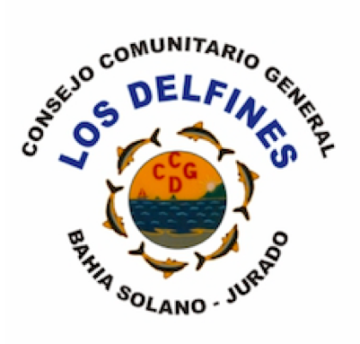
Monitoring Fish Landings by Coastal Communities
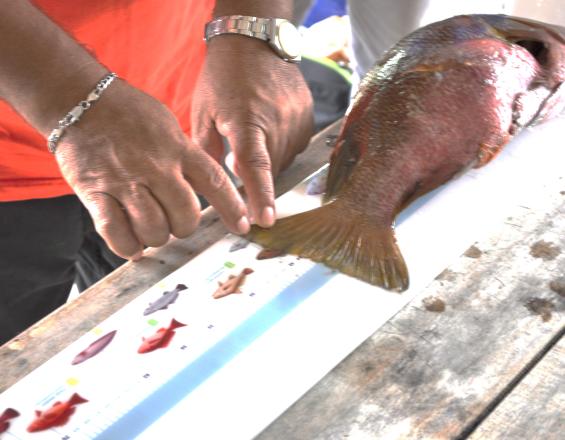
Lack of data on artisanal fisheries landings is a common element in tropical countries. The Participatory Monitoring Program includes the gathering and synthesis of biological information by organized groups of artisanal fishers. Multi-year data gathered by the fishers is presented and discussed with the community to highlight information on species, minimum sizes, volumes, trends and seasonality in the captures. This process has resulted in significant changes in fishing practices and management.
Contexte
Challenges addressed
- Poorly studied fish stocks
- Lack of monitoring systems & users not involved in management
- Fisheries authorities in the region lack data on how much fish and what species are caught by fishing communities in the Pacific.
- Without such information fisheries management cannot take place.
Emplacement
Traiter
Summary of the process
The development of trust allows insertion into the community in a more direct and transparent manner (BB1). Working together in defining problems that affect the community and possible solutions can help incorporate the community into the projects to solve those problems. Participatory monitoring was designed and implemented jointly by MarViva and communities because they had built a previous relationship. Its implementation was efficient and inexpensive (BB2). The results were returned and discussed regularly with the community so these were quickly used to change fishing practices, create an artisanal fishing zone and establish a marine protected area.
Building Blocks
Insertion in the community
A requirement to a community led participatory monitoring program is the prior development of strong relationship with the community leaders. The nature, objectives and methods to be used were discussed and agreed with the community before its implementation. Awareness on the lack of and the great value of fisheries landing data was clearly established within the community at the onset of the monitoring program.
Enabling factors
Keeping the same staff interacting with the communities so that trust is generated among people representing each party. Prior negotiation on how projects were going to be undertaken and which role the community will have in the activities. Maintaining constant communication with community representatives. Periodically reporting the results of the projects being implemented in the community.
Lesson learned
Set in advance the "rules of the game" with community representatives creates an environment of trust. The community involvement in the identification and design process, as well as in the activities, is also very beneficial. The return to the community of the information that was generated and the conclusions drawn from the data collected enables community ownership of the process. The development of this confidence and joint work allows MarViva to be inserted in the community and to be perceived as part of it, facilitating the implementation of processes.
Resources
Participatory methodologies to collect information
Over 25 communities in three countries, involving over 2000 fishers, have participated actively in this monitoring process for over 4 years. Young people were selected and trained in monitoring techniques and data compilation to identify species, measure length and weight and describe the gear used, capture location, and other variables.
Enabling factors
It was key to demonstrate the value of the process to fishermen to whom information was being returned and who benefit from this information. Keeping very low operational costs allows the program to run for several years. Simple methods and local people helped in keeping costs low. Having a fisheries expert to interpret and synthesize the data collected allows for better assessment of information.
Lesson learned
Engaging young people from fishing communities developed greater public interest in the data collected and in the status of the fishery resources.
Using simple techniques to measure variables such as weight and size proved to be highly efficient.
Simple methods and youth participation reduced costs of the monitoring program, making it more economical than traditional monitoring, which requires technical graduates.
Returning results to the fishing community allows them to understand the value of monitoring and what is happening with the fish resources in their area.
Keeping monitoring for several years generated information critical to delineate areas of artisanal fisheries and protected areas and to support the development of a responsible fishing program.
Impacts
Landings data gathered by the communities may be the only fisheries information available in remote coastal regions. Its low cost and the permanent presence of data gatherers have significantly improved fisheries statistics. The collection and presentation of this information has allowed the development of sustainable management plans for specific fishing grounds. Theses plans linked with awareness campaigns, changes in gear types and best practices agreements have improved fisheries management and reduced fishing impacts. As part of the process, Marine Protected Areas and Exclusive Artisanal Fishing Zones have been established with ample support from coastal communities. Also a 80% reduction in shark and ray captures has been achieved.
Beneficiaries
Over 25 communities in three countries, involving over 2000 fishers, have participated actively in this monitoring process for over 4 years.
Story
The lack of information on artisanal fisheries in the Pacific coast of Costa Rica, Colombia and Panama is an obstacle to the effective management of resources. As a result of the relationship established between MarViva and various community groups (such as fishermen's associations and community councils), the relevance of having information on fisheries resources was made clear to the communities. In 2010 groups of young people in 18 communities in the Chocó (Colombia) were trained in the collection of weight and length data and in fish species identification. Similar processes happened in Chiriqui and Veraguas in Panama (2012) and in the Gulf of Nicoya in Costa Rica (2013). The data collected are analyzed by technicians of MarViva, and the results are returned to the communities and discussed with them. This inexpensive process has allowed to train local people in the control of landings by artisanal fishermen in their communities and to form the best database on the artisanal fisheries in this region. In places like the Colombian Chocó, where we suspected that there was little pressure on resources, we found out that the main commercial species are already showing signs of over-exploitation. The results have been used to help raise awareness of fishermen about the effect of their activities on fish stocks and the need to change their fishing practices.



